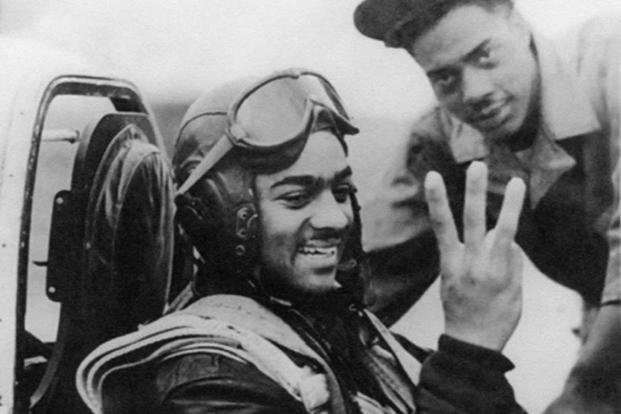Harry T. Stewart Jr., one of the original Tuskegee Airmen, who captured three aerial victories in World War II and was on the winning team for the Air Force’s first ever aerial gunnery competitive, died Feb. 2. He was 100.
Stewart grew up in New York City. At the age of 16, he tried to join the Army as an aviation cadet, shortly after the war in Europe began, but was rejected because Black men were not accepted for Army pilot training at that time. Soon after the U.S. entered the war, the policy changed, and the Army established a flight training program at Tuskegee Institute, Ala. On his second try, Stewart was accepted, becoming one of the first 1,000 men to train at Tuskegee Army Air Field.
After completing basic flight training there in June 1944, he went on to advanced training at Walterboro Field, S.C. He was assigned to the all-Black 332nd Fighter Group, where he flew P-51 Mustangs; one of the storied “Red Tails” who helped the bombers they escorted achieve a very high combat survivability rate.
On April 1, 1945, the 20-year-old Stewart, his wingman Walter Manning, and others from their Italy-based wing were flying P-51Ds, escorting B-24s on a bombing mission over Austria. On the way home, the flight struck ground targets of opportunity. Ambushed by a dozen FW-190s, Stewart shot down two of the attackers and maneuvered a third into the ground, achieving three aerial victories.
Although 10 of the 12 German fighters were destroyed, two of his fellow flight members were shot down, including Manning, who survived the bailout but was caught and lynched by area civilians.
Stewart received the Distinguished Flying Cross for his achievement that day and for actions across 43 total combat missions. Only three other Tuskegee Airmen downed three enemies in a single day.
When the war ended, Stewart remained in the Army Air Force, continuing to fly fighters as the service transitioned to become the U.S. Air Force. In 1949, he was part of a four-man team from the 332nd to win the first ever fighter gunnery meet “Top Gun,” flying P-47s against other units equipped with jets.
The Air Force did not publicize the achievement, however, and the trophy won by the team went missing more than 50 years. The team was recognized by the service in 2022 with a commemorative plaque at Nellis Air Force Base, Nev.
As part of a postwar reduction in force, Stewart left the Air Force in 1950, but was able to stay in the Air Force Reserve, eventually rising to become a lieutenant colonel. Though he tried to become an airline pilot, the airlines did not hire Black pilots at that time.
He enrolled in New York University and studied mechanical engineering, receiving his degree in 1963. He later landed a job with a natural gas pipeline company. He retired as its vice president in 1976.
Stewart maintained his flying currency and in later years took children up for flights, inspiring some to become pilots themselves. In 2019, he published a memoir of his wartime experiences, “Soaring to Glory: A Tuskegee Airman’s Firsthand Account of World War II.” The Tuskegee Airmen National Historical Museum in Detroit, Mich., honored him on July 4, 2024—his 100th birthday—with an event attended by state and national dignitaries.
The surviving Tuskegee Airmen were awarded the Congressional Gold Medal in 2019.
“Harry Stewart was a kind man of profound character and accomplishment with a distinguished career of service he continued long after fighting for our country in World War II,” said Brian Smith, President and CEO of the Tuskegee Airmen National Historical Museum. “We are deeply saddened by his passing and extend our condolences to his family and friends around the world.”
Stewart was believed to be one of the last two or three surviving original pilots from the Tuskegee Airmen.
